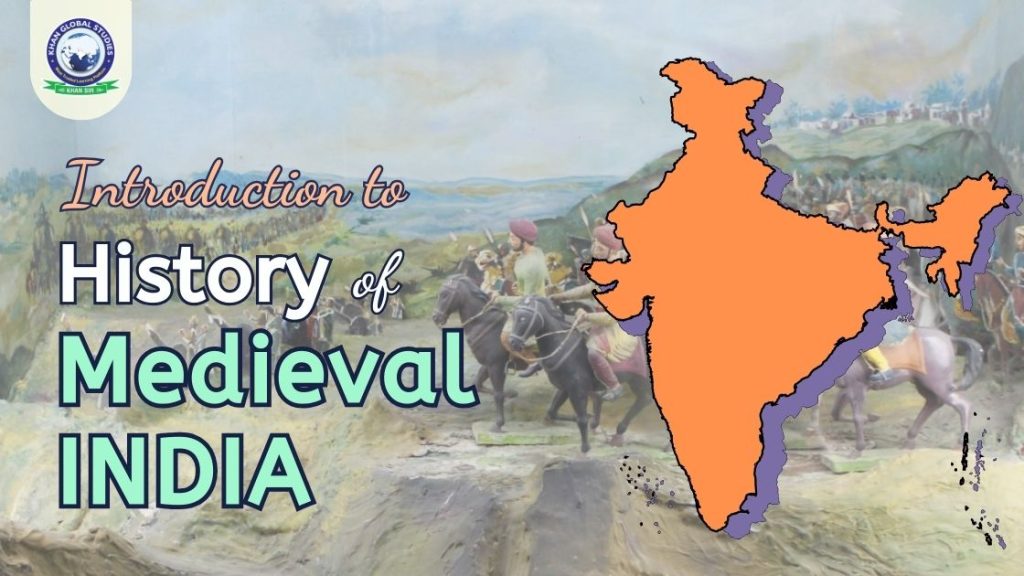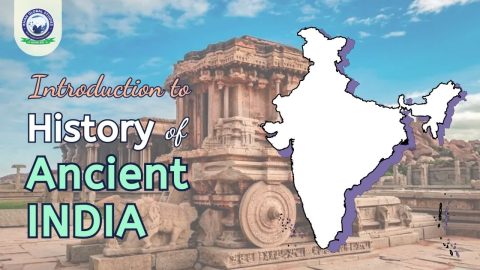Medieval India is considered to have begun with the Islamic invasion of India. Timur, ruler of present-day Uzbekistan, and Babur, a descendant of Genghis Khan, crossed the Khyber Pass in 1526 and established the Mughal Empire in present-day Afghanistan, Pakistan, India, and Bangladesh. With the arrival of Babar in India, the Mughal dynasty was established in India. The Mughal dynasty ruled India until 1600 AD. After 1700 AD, this dynasty began to decline and British rule began to spread. The Mughal dynasty was destroyed during India’s first war of independence in 1857. In this article, we will learn about the history of medieval India.
History of Medieval India
- Early Medieval period (8th to 11th century): This period saw the fall of the Gupta Empire and the beginning of the Delhi Sultanate, resulting in the division of India into some smaller kingdoms.
- Late Medieval period (12th to 18th century): During this period, Muslim invasions in the west gained momentum, while on the other hand, Ghulam dynasty, Khilji dynasty, Tughlaq dynasty, Syed dynasty and Lodi dynasty emerged in the Delhi Sultanate.
- Rise of the Vijayanagara Empire: The Vijayanagara Empire was founded by two brothers named Harihara and Bukka. It was the only Hindu kingdom at that time which was attacked by Alauddin Khilji. After Harihar and Bukka adopted the Muslim religion.
- Mughal Dynasty: The Delhi Sultanate came to an end with the beginning of the Mughal Dynasty. After Babar invaded India, the Mughal dynasty was established in India. With the Revolution of 1857, the Mughal dynasty collapsed and modern India began with British rule.
Anglo-Maratha War (एंग्लो-मराठा युद्ध)
One of the most important events in Indian history, the Anglo-Maratha War covers the events of the conflict between the Marathas and the British. The name of the ruler who was killed in the Third Battle of Panipat after the defeat of the Marathas in 1761 was Balajibaji Rao. He was fighting in the war started by his son Madhav Rao which had failed. While Balaji Bajirao’s brother Raghunath Rao became the next Peshwa. The British fought the first war with the Marathas after the death of Madhav Rao in 1772. Below is a summary of the events that took place during the Anglo-Maratha War that will help you understand this important phase of medieval India:
- After the death of Madhavrao I, conflict broke out in the Maratha camp. Narayanrao was on his way to becoming a Peshwa, however, his uncle Raghunathrao also wanted to become a priest.
- Therefore, after the intervention of the British, the Treaty of Surat was signed in 1775. According to the treaty, Raghunathrao gave 2500 soldiers to the British in exchange for Salsette and Bassein.
- Under Warren Hastings, the British Calcutta Council revoked this treaty and in 1776 the Treaty of Purandar was concluded between the Calcutta Council and a Maratha minister, Nana Phadnavis.
- As a result, only Raghunathrao was pensioned off and the British retained Salsette.
- However, the British establishment in Bombay violated this treaty and saved Raghunathrao.
- In 1777, Nana Fadnavis, going against his treaty with the Calcutta Council, granted a port on the west coast of France.
- For this reason, the British had to send him to Pune. A battle took place at Vadgaon near Pune in which the Marathas, led by Mahadji Shinde, claimed a decisive victory over the British.
- In 1779 the British were forced to sign the Treaty of Vadgaon.
- At the end of the Anglo-Maratha Wars, the Treaty of Salbai was concluded in 1782 which formed an important milestone in Indian history.
Growth of trade under the Mughal Empire
The rise of the Mughal Empire is also a turning point in Indian history. The advent of the Mughal Empire led to an increase in imports and exports in India. Foreign people like the Dutch, Jews, and British started coming to India for trade.
- There were a large number of Indian trading groups spread throughout the region. These included the Seths and Bohras, long-distance traders; Banik- local businessmen; Banjaras, who often travelled long distances with their goods on the backs of oxen, were another class of traders who specialized in the transportation of bulk goods. In addition, heavy goods were transported on boats across rivers.
- Gujarati traders were Hindus, Jains and Muslims, while in Rajasthan, Oswals, Maheshwaris and Agarwals came to be known as Marwaris.
- In South India, the most important trading societies were those of the Coromandel, the Chettis, the Muslim Malabar traders on the Bengal coast, etc. – who traded in sugar, rice as well as delicate muslin and silk.
- Gujarat, from where fine cloth and silk were transported to northern India, was an entry point for foreign goods. Some metals such as metals were the main imports into India. Imports of luxury goods including copper and tin, warhorses and warhorses, ivory, gold and silver are balanced by trade.
Art and Architecture under the Mughal Empire
Many Indian historical monuments were built during the reign of the Mughals and became an essential part of Indian history. Here is a summary of popular art and architecture under the Mughal Empire:
- The Mughals were fond of creating gardens with flowing water. Some of the Mughal gardens are Nishat Bagh in Kashmir, Shalimar Bagh in Lahore and Pinjore Bagh in Punjab.
- During Sher Shah’s reign, the mausoleum at Sasaram in Bihar and the Purana Qila near Delhi were built.
- Construction of buildings started on a large scale during the reign of Akbar. Many forts were designed by him and the most prominent was the Agra Fort. It was constructed from red sandstone. His other strongholds are in Lahore and Allahabad.
- The famous Red Fort in Delhi was built by Shahjahan along with Rang Mahal, Diwan-e-Aam and Diwan-e-Khwaswa.
- A palace cum fort complex at Fatehpur Sikri was also built by Akbar (Vijay City).
- Many Gujarati and Bengali-style buildings are also found in this complex.
- The buildings were probably built in Gujarati style for their Rajput mothers. The grandest structure in it is the Jama Masjid and its gateway, known as Buland Darwaza or Buland Gate.
- The height of the entrance gate is 176 feet. It was built to commemorate Akbar’s victory over Gujarat.
- Jodhabai’s Palace and the five-storey Panch Mahal are other important buildings of Fatehpur Sikri.
- Humayun’s Tomb was built during the reign of Akbar in Delhi and has a massive marble dome.
- Akbar’s tomb was built by Jahangir in Sikandra near Agra.
- Itamdaula’s tomb in Agra was built by Nur Jahan.
- The Taj Mahal was built entirely of white marble and had floral designs made of semi-precious stones on its walls. This method became more popular during the reign of Shahjahan. Built by Shah Jahan, the Taj Mahal is considered one of the seven wonders of history. The pietra dura process was used extensively for its construction. It includes all the architectural forms that were created by the Mughals. The main beauty of the Taj is the elaborate dome and four slender minarets whose decoration has been kept to a minimum.
History of Awadh
Important events in the history of Awadh in Indian history are given below:
- Awadh was a historical region in northern India, now the north-eastern part of the state of Uttar Pradesh. It was named after the Kosala capital of the Ayodhya Kingdom and became part of the Mughal Empire in the 16th century.
- In 1800 the British made it a part of their empire. When the Awadh province became independent in 1722 AD, the Mughal Emperor Muhammad Shah appointed Saadat Khan, a Persian Shia, as the governor of Awadh.
- Saadat Khan helped in overthrowing the Sayyid brothers. Saadat Khan was appointed by the king to negotiate with Nadir Shah to persuade him to return to his country in exchange for the destruction of the city and payment of a large sum of money. When Nadir Shah failed to receive the money as promised, his anger was felt by the people of Delhi. He ordered general slaughter. Saadat Khan committed suicide due to disgrace and shame.
- Safdar Jang, also known as the Wazir of the Mughal Empire, was the next Nawab of Awadh. He was succeeded by his uncle Shuja-ud-Daula. A strong army was organized by the Awadh king, which included Nagas and Sanyasis as well as Muslims and Hindus. The Awadh ruler had authority up to Rohilkhand, the area east of Delhi. A large number of Afghans settled in it from the mountain ranges of the North-West Frontier, called the Rohills.
Summary of Nawabs of Awadh
- Saadat Khan Burhan-ul-Mulk (1722-1739 AD): As an autonomous state, he established the Mughal Empire in 1722 AD. Established Awadh. During the invasion of Nadir Shah, he was named governor by the Mughal emperor Muhammad Shah and played a very important role in imperial affairs until he committed suicide for the sake of name and honour.
- Safdar Jang/Adbul Mansoor (1739-1754 AD): Saadat Khan, who participated in the battle of Manpur against Ahmed Shah Abdali, was the son-in-law of Saadat Khan (1748 AD).
- Shuja-ud-Daula (1754-1775 AD): Son of Safdarjung, he was an ally of Ahmed Shah Abdali of Afghanistan. After defeating the Rohillas with the help of the British, he returned Rohilkhand to Awadh in 1774 AD.
- Asaf-ud-Daula: He was famous for promoting the culture of Lucknow and built important monuments like Imambara and Rumi Darwaza. He signed the Treaty of Faizabad (AD 1755) with the British.
- Wajid Ali Shah: He was widely known as Jaan-e-Alam and Akhtar Piya and was the last king of Awadh, but due to a misunderstanding he was deposed by the British Lord Dalhousie. Artists of classical music and dance like the Kalka-Binda brothers used to get a place in the court there.





